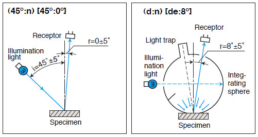Color Measurement Instrument Geometries
An object may appear brighter, duller, lighter, or darker depending on the angle at which it is viewed. This is because viewing angles directly affect how light reflects from the object to our eyes. To evaluate and control an object’s color using a standardized method, light must reflect off of the object at the same angles during each assessment.
Color measurement instruments, including spectrophotometers and colorimeters, illuminate an object at certain angles to detect its color. The angle at which the object is illuminated and the angle at which its reflected light is detected is the instrument’s optical system geometry. An instrument’s geometry influences where an object’s color falls within the defined color space and may generate different measurement results from instruments with other geometries.
To identify which geometry is ideal for evaluating and controlling the color of your samples, it should be understood how each of these illuminate an object and detect its color. Below we describe the common geometries built within color measurement instruments.
Unidirectional Illumination Systems: 45/0, 0/45
Unidirectional illumination systems illuminate an object from one direction, or angle, and exclude any specular reflected light. Instruments with this type of geometry are sensitive to surface conditions, making it ideal for users interested in measuring the appearance of a sample’s color rather than its “true” color. A glossy object dyed a navy blue would fall in a darker, more saturated region of the defined color space, for example, while a rough-surfaced object dyed the exact same blue color would fall in a lighter, less saturated region of the defined color space.
Unidirectional illumination systems are ideal for:
- Quality control evaluations to ensure each batch of material maintains consistency in the appearance of their color and meets standard specifications
- Measuring the appearance of samples with glossy or shiny surfaces
- Comparing samples with the same texture, gloss, or surface condition to ensure consistency in the appearance of their color
There are two common types of unidirectional illumination systems, including 45/0 and 0/45. An instrument with 45/0 geometry illuminates an object from a 45 degree angle and detects the reflected light at 0 degrees. An instrument with 0/45 geometry illuminates an object at 0 degrees and detects the reflected light at a 45 degree angle.
Diffused Illumination Integrating Sphere Systems: d/8, 8/d
Diffused illumination integrating sphere systems illuminate an object uniformly from all directions, or angles. Instruments with this type of geometry can perform measurements in either Specular Component Included (SCI) mode or Specular Component Excluded (SCE) mode, making it ideal for measuring the “true” color of a sample and the appearance of its color (e.g., effects of gloss).
Sphere illumination systems are ideal for:
- Formulating recipes to match colors and meet color quality standards (SCI mode)
- Measuring the color of samples with textured, rough, or irregular surfaces
- Comparing samples with different textures and surface conditions to ensure consistency in their color
There are two general types of sphere illumination systems, including d/8 and 8/d, with “d” referring to diffuse. An instrument with d/8 geometry illuminates an object from scattered directions and detects the reflected light at an 8 degree angle. An instrument with 8/d geometry illuminates an object at an 8 degree angle and detects the reflected light from scattered directions.
When deciding which geometry best fits your application needs, it is important to remember:
- To only evaluate the appearance of a sample’s color, a unidirectional illumination system is typically the geometry of choice.
- To evaluate the “true” color of a sample, a sphere illumination system in Specular Component Included (SCI) mode is the geometry of choice. To evaluate the “true” color of a sample AND the appearance of a sample’s color, a sphere illumination system with Specular Component Included (SCI) mode and Specular Component Excluded (SCE) mode is required.
Learn more about SCI and SCE measurement modes here
Like this article? Click here to sign up for our monthly Color Trends & Technology newsletter to stay updated on the element of color, best practices for controlling and evaluating the color of objects, educational seminars, and advanced technology for research and manufacturing environments.
The technological leader in color and light measurement solutions, Konica Minolta Sensing Americas helps organizations formulate, evaluate, and control color to meet product quality and operational goals more efficiently.










